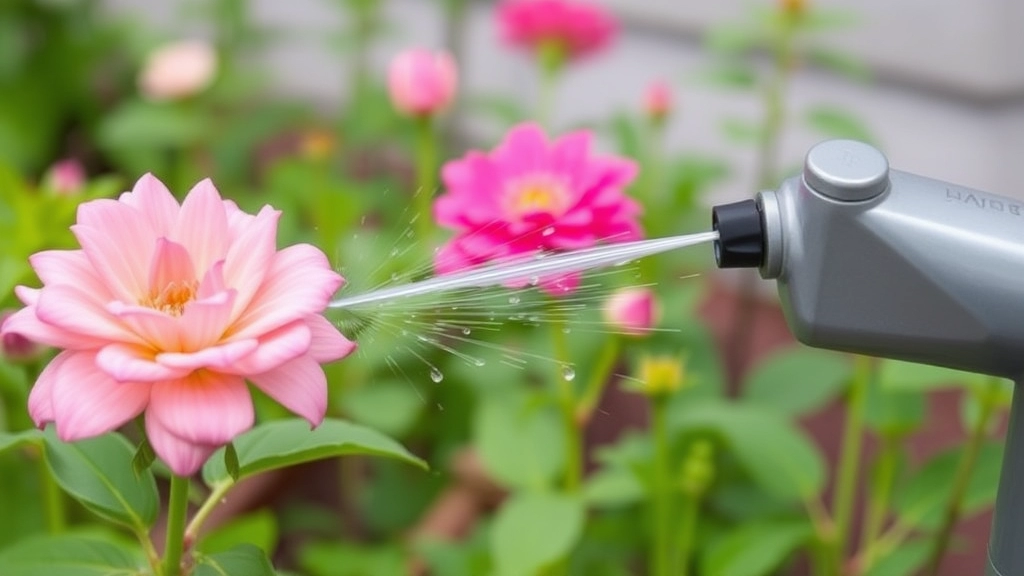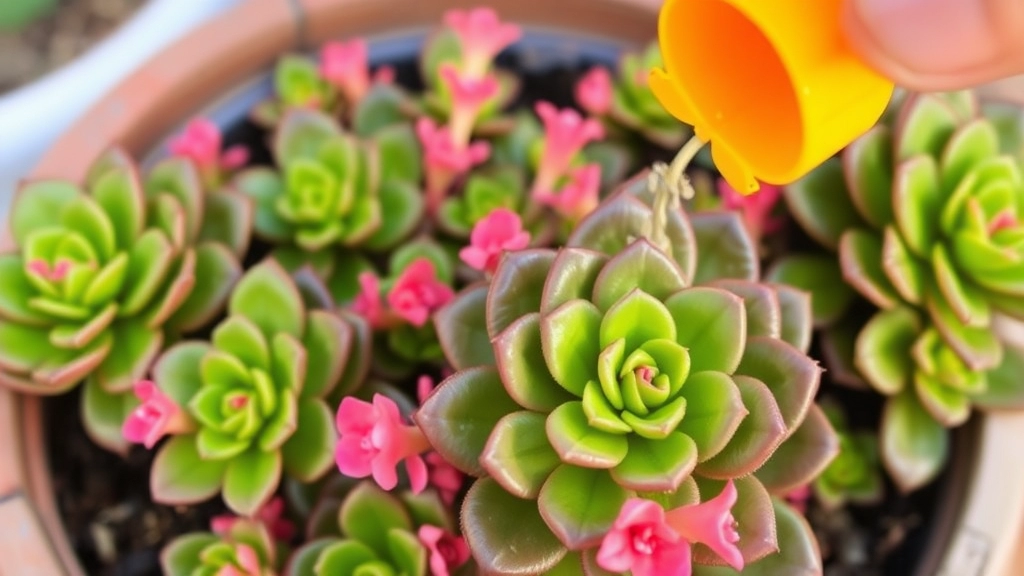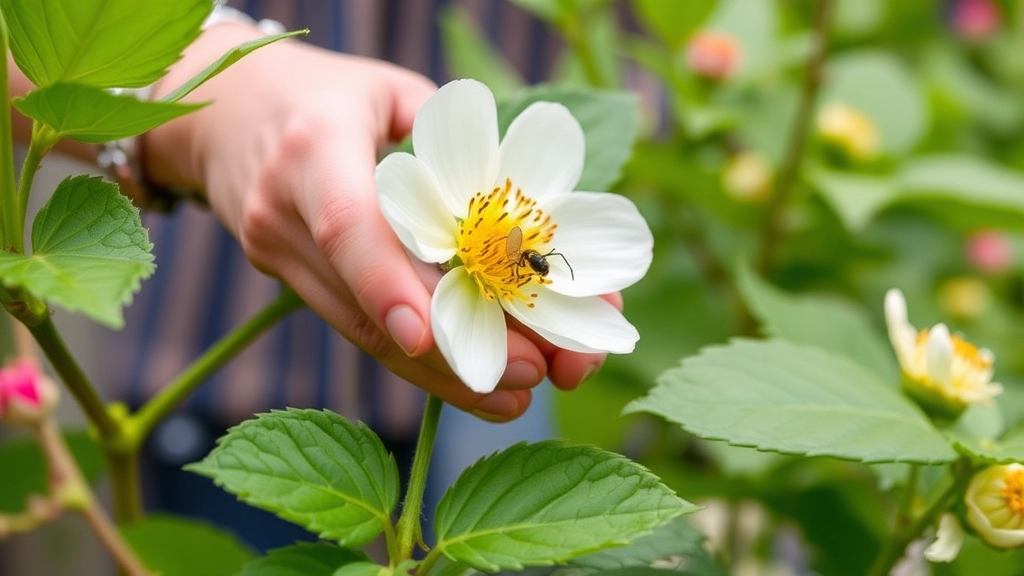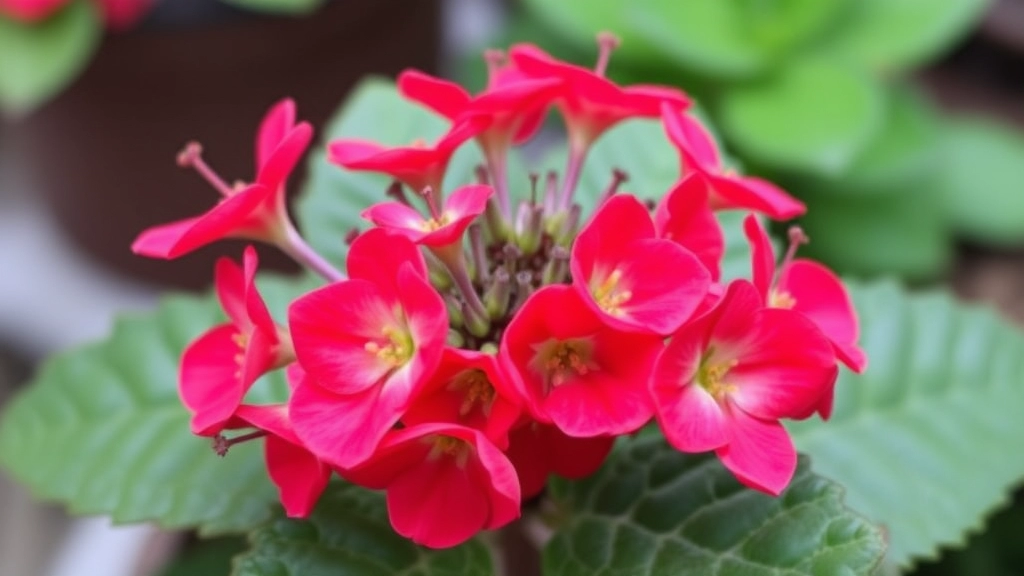Care Tips for Kalanchoe After Flowering
Looking for tips on the care of kalanchoe after flowering? You’ve come to the right place. As a kalanchoe enthusiast, I know how important it is to keep these vibrant succulents healthy and blooming. After the flowering phase, proper care is crucial to ensure your plant thrives. Let’s dive into some practical steps to keep your kalanchoe in top shape.
Essential Care Steps
- Pruning: Once the blooms fade, trim away dead flowers and any leggy growth to encourage new shoots.
- Watering: Adjust your watering schedule—kalanchoes need less water post-bloom.
- Light and Temperature: Make sure your plant gets plenty of indirect sunlight and stays in a warm environment.
By following these simple tips, you’ll set the stage for your kalanchoe to bloom again.
Best Practices for Pruning Kalanchoe After Flowering
After your Kalanchoe has finished blooming, you may wonder how to care for it moving forward. Pruning is a vital step in maintaining a healthy plant and encouraging future growth.
Why Prune?
Pruning serves several essential purposes:
- Promotes Growth: Removing spent flowers and dead leaves allows the plant to redirect energy to new growth.
- Enhances Appearance: A well-pruned Kalanchoe looks tidier and more vibrant.
- Prevents Disease: Cutting away dead or diseased parts reduces the risk of infections.
When to Prune
Timing is crucial. The best time to prune your Kalanchoe is right after the blooming period, typically in late spring or early summer. This allows the plant to recover quickly and prepare for its next growth phase.
How to Prune
Here’s a straightforward guide to pruning your Kalanchoe:
- Gather Your Tools: Use clean, sharp scissors or pruning shears to prevent any infections.
- Identify What to Cut:
- Remove spent flowers by cutting the stem just above the first set of healthy leaves.
- Trim away any yellow or dead leaves to promote overall health.
- Make Clean Cuts: Ensure your cuts are smooth to minimize stress on the plant.
- Don’t Overdo It: Aim to remove about one-third of the plant at a time. This encourages healthy growth without overwhelming the Kalanchoe.
Aftercare
Once you’ve pruned, it’s essential to provide the right aftercare:
- Watering: Adjust your watering routine, which we will discuss next.
- Light: Ensure your Kalanchoe receives adequate light to stimulate new growth.
For more detailed guidance on post-flowering care, check out our Post-Flowering Care Tips for Kalanchoe. Additionally, if you’re having trouble with your Kalanchoe not blooming again, our article on Why Your Non-Flowering Kalanchoe Isn’t Blooming: Tips & Fixes might provide some helpful insights.
How to Adjust Watering After the Bloom Period

So, your Kalanchoe has finished flowering, and you’re probably wondering how to adjust your watering routine.
It’s a common concern. After all, the last thing you want is to drown or deprive your plant of water at this crucial time.
Here’s how to get it right:
- Reduce Frequency: After the blooming phase, your Kalanchoe doesn’t need as much water. Cut back on watering to about once every two weeks.
- Check Soil Moisture: Always check the soil before watering. Stick your finger about an inch into the soil. If it feels dry, it’s time to water. If it’s still moist, hold off a bit longer.
- Seasonal Adjustments: As the weather changes, so should your watering. In warmer months, you might need to water more frequently, while in cooler months, let the soil dry out more between waterings.
- Signs of Overwatering: Yellowing leaves or a mushy stem are red flags. If you notice these, it’s a sign to cut back on the water immediately.
- Signs of Underwatering: If the leaves look shriveled or the plant appears droopy, it’s time to give it a drink.
Adjusting your watering routine is crucial for keeping your Kalanchoe healthy and vibrant post-bloom.
Encouraging Reblooming: Light and Temperature Tips
After enjoying the vibrant blooms of your Kalanchoe, you might be wondering how to coax those beautiful flowers back for another round.
Light Requirements
Kalanchoe thrives in bright, indirect sunlight. To encourage reblooming, consider the following:
- Optimal Location: Place your plant near a south or west-facing window. This ensures it receives ample light without direct scorching rays.
- Duration of Light: Aim for about 12-14 hours of light daily. If natural light is limited, consider using grow lights to supplement.
- Avoid Sudden Changes: If you need to move your plant, do so gradually to prevent shock.
Temperature Control
Temperature plays a crucial role in the blooming cycle of Kalanchoe. Here’s how to create the perfect environment:
- Ideal Range: Keep your Kalanchoe in a temperature range of 18-24°C (65-75°F) during the day and slightly cooler at night.
- Avoid Cold Drafts: Protect your plant from chilly drafts or sudden temperature changes, as this can hinder blooming.
- Seasonal Adjustments: During the winter months, ensure your plant is kept in a warmer area, as Kalanchoe can be sensitive to cold.
For more detailed care tips, you might find our Ultimate Guide to Flowering Kalanchoe Care Tips for Blooming helpful. Additionally, if you’re dealing with any specific issues like leaf discoloration, our article on Why Kalanchoe Leaves Turn Red: Causes and Solutions could provide valuable insights.
Fertilizing Kalanchoe for Continued Growth

After ensuring your Kalanchoe receives the right care post-flowering, it’s essential to focus on fertilizing to promote continued growth. Many plant enthusiasts often worry about how to best nourish their plants after the bloom period.
Why Fertilizing Matters
Fertilizing is crucial for replenishing nutrients that your Kalanchoe may have depleted during its flowering phase. A well-fertilised plant is more resilient and can thrive through the growing season.
Best Fertilizer Choices
When choosing a fertilizer for Kalanchoe, consider the following options:
- Balanced Fertilizer: Use a balanced, water-soluble fertiliser with an N-P-K ratio of 10-10-10. This provides equal parts of nitrogen, phosphorus, and potassium.
- Cactus/Succulent Fertilizer: A specialised cactus or succulent fertiliser can also work well, as it typically has lower nitrogen levels, which is ideal for Kalanchoe.
- Organic Options: If you prefer organic, consider using compost or well-rotted manure. These enrich the soil and offer slow-release nutrients.
When to Fertilize
Timing is key. Fertilize your Kalanchoe:
- Every 4-6 weeks during the growing season (spring and summer).
- Avoid fertilizing during the dormant months (autumn and winter).
Application Tips
To ensure effective fertilization, follow these steps:
- Dilute the Fertilizer: Always dilute the fertilizer to half-strength to prevent root burn.
- Water Before Application: Water your Kalanchoe a day before fertilizing to help the plant absorb nutrients more effectively.
- Apply Evenly: Distribute the fertilizer evenly around the base of the plant, avoiding direct contact with the leaves.
- Monitor: Keep an eye on your plant’s response. If you notice yellowing leaves, it may indicate over-fertilization.
By following these fertilization guidelines, your Kalanchoe will be well-equipped to continue its growth after flowering.
Repotting Kalanchoe: When and How to Do It
After enjoying the vibrant blooms of your Kalanchoe, you might be wondering about the next steps in caring for your plant. One essential task is repotting, which can significantly affect its health and growth.
When to Repot Kalanchoe
- Timing: The best time to repot Kalanchoe is in spring, just before the growing season begins. This allows the plant to settle into its new pot while it’s actively growing.
- Signs Your Plant Needs Repotting:
- Roots are growing out of the drainage holes.
- The plant appears top-heavy or is falling over.
- Soil dries out too quickly after watering.
How to Repot Kalanchoe
- Choose the Right Pot:
- A pot that is 1-2 inches larger in diameter than the current one is ideal.
- Ensure it has drainage holes to prevent waterlogging.
- Select the Right Soil:
- Use a well-draining potting mix, such as a cactus or succulent mix.
- You can also create your own by mixing standard potting soil with sand or perlite.
- Repotting Steps:
- Gently remove the Kalanchoe from its old pot, taking care not to damage the roots.
- Loosen any tightly bound roots.
- Place the plant in the new pot and fill in with fresh soil, ensuring the base of the plant is level with the pot rim.
- Water the plant lightly to help settle the soil.
By repotting your Kalanchoe, you provide it with fresh nutrients and more space to grow, which is crucial for its continued health. For more tips on maintaining healthy Kalanchoe plants, check out our Kalanchoe Blossfeldiana leaf care tips. Additionally, learn how to ensure your plant thrives with our Kalanchoe Beharensis care guide.
Preventing Pests and Diseases After Flowering

So, your Kalanchoe has finished blooming, and you’re feeling pretty chuffed with its performance. But hold on—what about those pesky pests and sneaky diseases that could crash the party? It’s a real concern for many plant parents, and trust me, I’ve been there too.
Keep an Eye Out for Common Pests
First things first, let’s talk about the usual suspects:
- Mealybugs: These little white fluff balls love to hide in the nooks and crannies.
- Spider Mites: Tiny and often invisible, they can suck the life out of your plant.
- Aphids: These green or black critters can multiply quickly and cause damage.
To keep them at bay, check your Kalanchoe regularly. A quick inspection can save you a lot of headaches later on.
Simple Prevention Tips
Here are some straightforward tips to keep your plant healthy:
- Clean Leaves: Wipe down the leaves with a damp cloth. It removes dust and makes it harder for pests to settle in.
- Good Air Circulation: Ensure your plant isn’t cramped. A little space goes a long way in preventing diseases.
- Proper Watering: Overwatering can lead to root rot, which attracts pests. Stick to a routine and let the soil dry out between waterings.
Disease Awareness
Now, let’s chat about diseases. Fungal infections can be a real downer for your Kalanchoe.
- Powdery Mildew: This white, powdery substance can appear if the humidity is too high.
- Root Rot: Caused by overwatering, it’s often a silent killer.
To dodge these issues, ensure your plant has good drainage.
Natural Remedies
If you do spot a pest or disease, don’t panic! Here are some natural remedies you can try:
- Neem Oil: A great natural pesticide. Just mix it with water and spray it on your plant.
- Insecticidal Soap: This can help get rid of those unwanted guests without harming your plant.
Staying vigilant and acting quickly can make all the difference.
Propagation Techniques for Kalanchoe Post-Bloom
After successfully pruning and caring for your Kalanchoe, you might be wondering how to multiply this beautiful plant. Propagation is an excellent way to create new plants from your existing ones, ensuring that you can enjoy their vibrant blooms for years to come.
Here are some effective propagation techniques for Kalanchoe after the bloom period:
1. Leaf Cuttings
- Select Healthy Leaves: Choose mature, healthy leaves from the parent plant.
- Cut and Dry: Using a clean, sharp knife, cut the leaf at the base. Allow it to dry for a few days to form a callus.
- Planting: Place the callused leaf on well-draining soil, ensuring the cut end is in contact with the soil. Mist lightly.
2. Stem Cuttings
- Choose a Stem: Select a healthy stem with several leaves.
- Cut and Dry: Cut the stem just below a leaf node and let it dry for a day or two.
- Rooting: Place the cutting in a pot with well-draining soil and water lightly. Keep the soil moist but not soggy.
3. Offsets
- Identify Offsets: Look for small offsets or pups at the base of the parent plant.
- Remove Carefully: Gently twist or cut the offset from the parent plant.
- Replant: Plant the offset in its own pot with fresh soil, watering lightly.
4. Water Propagation
- Choose a Cutting: Use either a leaf or stem cutting.
- Place in Water: Submerge the cut end in water, ensuring no leaves touch the water.
- Roots Development: Change the water regularly and wait for roots to develop before transferring to soil.
For more detailed guidance on propagating different Kalanchoe varieties, check out our guide on propagating Kalanchoe Mother of Thousands and our step-by-step guide on propagating Kalanchoe leaves.
FAQs on Care of Kalanchoe After Flowering
How should I adjust my watering routine after my Kalanchoe has finished flowering?
After the blooming phase, reduce the watering frequency to about once every two weeks. Always check the soil moisture before watering and adjust based on seasonal changes. Watch for signs of overwatering like yellowing leaves and underwatering like shriveled leaves.
What type of fertilizer is best for Kalanchoe post-flowering?
Use a balanced, water-soluble fertilizer with an N-P-K ratio of 10-10-10, or a specialized cactus or succulent fertilizer. Organic options like compost or well-rotted manure are also beneficial.
When should I fertilize my Kalanchoe?
Fertilize every 4-6 weeks during the growing season (spring and summer). Avoid fertilizing during the dormant months (autumn and winter).
How can I prevent pests and diseases after my Kalanchoe has bloomed?
Regularly inspect your plant for common pests like mealybugs, spider mites, and aphids. Maintain good air circulation, clean the leaves, and ensure proper watering to avoid root rot and fungal infections. Use natural remedies like neem oil and insecticidal soap if pests are detected.
Why is it important to fertilize Kalanchoe after flowering?
Fertilizing replenishes nutrients depleted during the flowering phase, promoting continued growth and resilience throughout the growing season.
How can I apply fertilizer effectively to my Kalanchoe?
Always dilute the fertilizer to half-strength, water the plant a day before application, and distribute the fertilizer evenly around the base. Monitor your plant’s response and adjust as needed.
What are the signs of overwatering and underwatering in Kalanchoe?
Signs of overwatering include yellowing leaves and a mushy stem, while underwatering is indicated by shriveled leaves and a droopy appearance.
What should I do if I notice pests on my Kalanchoe?
If you spot pests, use natural remedies like neem oil or insecticidal soap. Regularly cleaning the leaves and ensuring good air circulation can also help prevent infestations.
How can I prevent fungal diseases in my Kalanchoe?
Ensure your plant has good drainage to avoid root rot and maintain proper humidity levels to prevent powdery mildew. Regularly clean the leaves and avoid overwatering.
References
-
How to Adjust Watering After the Bloom Period
-
Fertilizing Kalanchoe for Continued Growth
-
Preventing Pests and Diseases After Flowering
